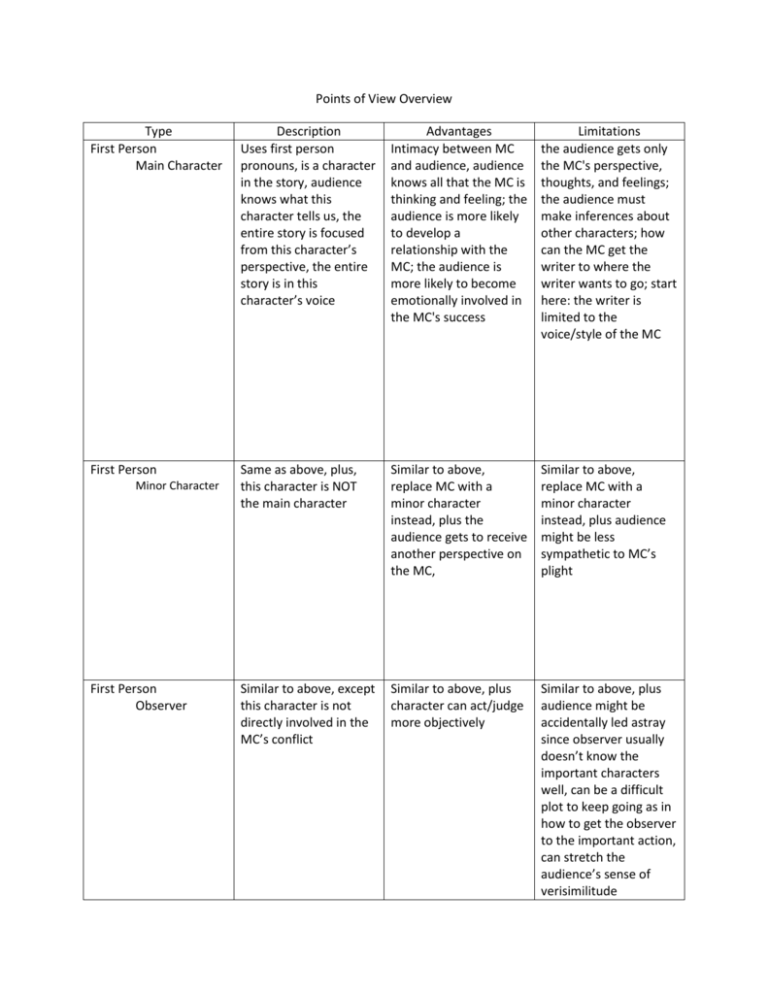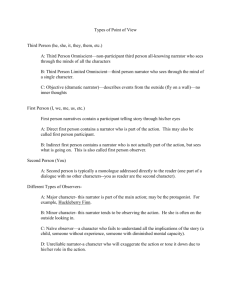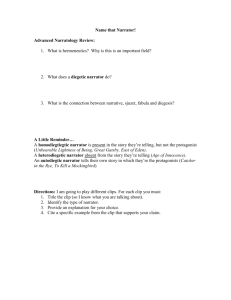File
advertisement

Points of View Overview Type First Person Main Character Description Uses first person pronouns, is a character in the story, audience knows what this character tells us, the entire story is focused from this character’s perspective, the entire story is in this character’s voice Advantages Intimacy between MC and audience, audience knows all that the MC is thinking and feeling; the audience is more likely to develop a relationship with the MC; the audience is more likely to become emotionally involved in the MC's success Limitations the audience gets only the MC's perspective, thoughts, and feelings; the audience must make inferences about other characters; how can the MC get the writer to where the writer wants to go; start here: the writer is limited to the voice/style of the MC First Person Same as above, plus, this character is NOT the main character Similar to above, replace MC with a minor character instead, plus the audience gets to receive another perspective on the MC, Similar to above, replace MC with a minor character instead, plus audience might be less sympathetic to MC’s plight Similar to above, except this character is not directly involved in the MC’s conflict Similar to above, plus character can act/judge more objectively Similar to above, plus audience might be accidentally led astray since observer usually doesn’t know the important characters well, can be a difficult plot to keep going as in how to get the observer to the important action, can stretch the audience’s sense of verisimilitude Minor Character First Person Observer Second Person Uses second person pronoun a lot, Basically, this POV includes the reader in the story, the reader takes on the persona of one of the characters Experimental, can enable the audience to feel more a part of the action, can enable the audience to more intimately feel things he or she may not have felt before, “you feel that you are being mistreated…” Experimental, rarely done, this “persona” might not fit the actual reader, might feel too much of an emotional “stretch”, audience might recoil at being identified as this persona, audience might not want to feel or think the things being attributed to “you”, excessive you of “you” can be annoying Third Person Omniscient, “all-seeing” Uses third person pronouns, narrator follows all the characters as they interact in the story, narrator is not a character in the story, narrator must still have a “voice”, generally, narrator should avoid making judgments, narrator can focus in one different characters in different scenes or within scenes Narrator can know all characters’ thoughts and feelings, narrator can travel to any character or group at any time past, present, or future Voice can accidentally take on the author’s voice , can feel unrealistic for an audience, can be difficult to keep it going for the writer, can be difficult to juggle multiple thoughts and feelings in the same scene, can be very long, can provide excessive detail, audience can feel too distant from character since information is being filtered through narrator Third Person Limited Similar to above, but narrator follows only ONE character, narrator knows only that character’s thoughts and feelings directly, narrator can switch to a different character but only when a new scene begins Similar to first person on page one Similar to first person on page one, audience can feel too distant from character since information is being filtered through narrator Third Person Dramatic Similar to first person observer, however, the narrator is required to NOT have a “voice”/personality, narrator does not judge or know the thoughts and feelings of any characters-except through dialogue and behavior, dialogue heavy, similar to a play Avoids narrator “intrusion”—when the narrator’s opinions get in the way of the story, can provide a more deliberate focus on WHAT happens rather than characters’ internal lives audience can feel too distant b/c no thoughts and feelings are presented, story can feel “dry”, narrative voice can be difficult to write








